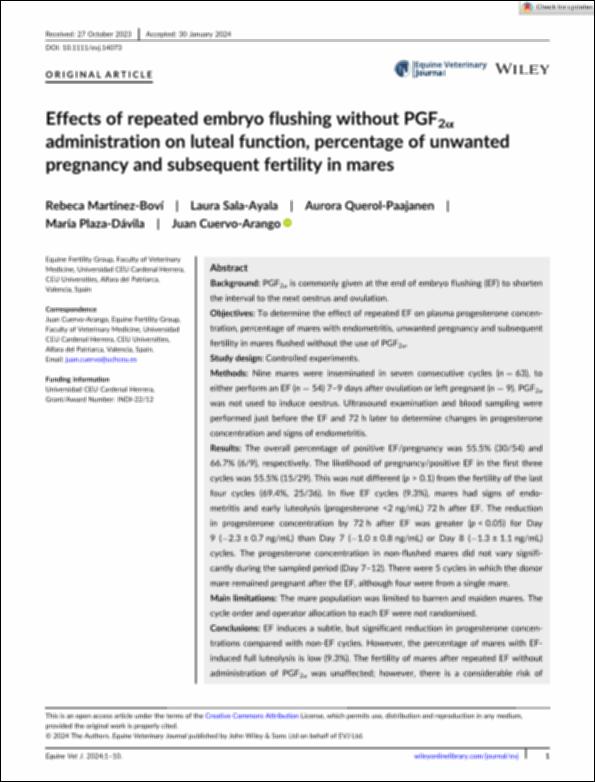Por favor, use este identificador para citar o enlazar este ítem:
http://hdl.handle.net/10637/15863Effects of repeated embryo flushing without PGF2α administration on luteal function, percentage of unwanted pregnancy and subsequent fertility in mares
| Título : | Effects of repeated embryo flushing without PGF2α administration on luteal function, percentage of unwanted pregnancy and subsequent fertility in mares |
| Autor : | Martínez Boví, Rebeca Sala Ayala, Laura Querol Paajanen, Aurora Plaza Dávila, María Cuervo-Arango Lecina, Juan |
| Materias: | Veterinaria; Veterinary medicine; Caballo; Horses; Embarazo; Pregnancy; Embrión; Embryos; Progesterona; Progesterone; Cuerpo lúteo; Corpus luteum; Genética animal; Animal genetics |
| Editorial : | John Wiley & Sons |
| Citación : | Martínez-Boví, R., Sala-Ayala, L., Querol-Paajanen, A., Plaza-Dávila, M. & Cuervo-Arango, J. (2024). Effects of repeated embryo flushing without PGF2α administration on luteal function, percentage of unwanted pregnancy and subsequent fertility in mares. Equine Veterinary Journal, Advance online publication. DOI: https://doi.org/10.1111/evj.14073 |
| Resumen : | Background: PGF2α is commonly given at the end of embryo flushing (EF) to shorten the interval to the next oestrus and ovulation. Objectives: To determine the effect of repeated EF on plasma progesterone concentration, percentage of mares with endometritis, unwanted pregnancy and subsequent fertility in mares flushed without the use of PGF2α. Study design: Controlled experiments. Methods: Nine mares were inseminated in seven consecutive cycles (n = 63), to either perform an EF (n = 54) 7–9 days after ovulation or left pregnant (n = 9). PGF2α was not used to induce oestrus. Ultrasound examination and blood sampling were performed just before the EF and 72 h later to determine changes in progesterone concentration and signs of endometritis. Results: The overall percentage of positive EF/pregnancy was 55.5% (30/54) and 66.7% (6/9), respectively. The likelihood of pregnancy/positive EF in the first three cycles was 55.5% (15/29). This was not different (p > 0.1) from the fertility of the last four cycles (69.4%, 25/36). In five EF cycles (9.3%), mares had signs of endometritis and early luteolysis (progesterone <2 ng/mL) 72 h after EF. The reduction in progesterone concentration by 72 h after EF was greater (p < 0.05) for Day 9 (−2.3 ± 0.7 ng/mL) than Day 7 (−1.0 ± 0.8 ng/mL) or Day 8 (−1.3 ± 1.1 ng/mL) cycles. The progesterone concentration in non-flushed mares did not vary significantly during the sampled period (Day 7–12). There were 5 cycles in which the donor mare remained pregnant after the EF, although four were from a single mare. Main limitations: The mare population was limited to barren and maiden mares. The cycle order and operator allocation to each EF were not randomised. Conclusions: EF induces a subtle, but significant reduction in progesterone concentrations compared with non-EF cycles. However, the percentage of mares with EF-induced full luteolysis is low (9.3%). The fertility of mares after repeated EF without administration of PGF2α was unaffected; however, there is a considerable risk of unwanted pregnancy (5/27 = 18.5%) in donors from which an embryo was not recovered. |
| URI : | http://hdl.handle.net/10637/15863 |
| Derechos: | http://creativecommons.org/licenses/by/4.0/deed.es Open Access |
| ISSN : | 0425-1644 2042-3306 (Electrónico) |
| Cubierto por: | Acuerdo Transformativo – 2024 |
| Fecha de publicación : | 25-feb-2024 |
| Centro : | Universidad Cardenal Herrera-CEU |
| Aparece en las colecciones: | Dpto. Medicina y Cirugía Animal |
Los ítems de DSpace están protegidos por copyright, con todos los derechos reservados, a menos que se indique lo contrario.


